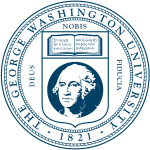 | |
| Former names | Columbian College (1821–1873) Columbian University (1873–1904) |
|---|---|
| Motto | Latin: Deus Nobis Fiducia |
| Motto in English | "God is Our Trust" |
| Type | Private federally chartered research university |
| Established | February 9, 1821; 203 years ago (1821-02-09) |
| Accreditation | MSCHE |
| Academic affiliations | |
| Endowment | $2.8 billion (2024) |
| President | Ellen Granberg |
| Provost | Christopher Bracey |
| Academic staff | 2,663 |
| Students | 26,457 (2021) |
| Undergraduates | 11,502 (2021) |
| Postgraduates | 14,955 (2021) |
| Location | Foggy Bottom, Washington, D.C., U.S. |
| Campus | Large city, 43 acres (17 ha) |
| Newspaper | The GW Hatchet |
| Colors | Buff and blue |
| Nickname | Revolutionaries |
| Sporting affiliations | |
| Mascot | George |
| Website | www |
 | |
The George Washington University (GW or GWU) is a private federally-chartered research university in Washington, D.C., United States. Originally named Columbian College, it was chartered in 1821 by the United States Congress and is the first university founded under Washington, D.C.'s jurisdiction. It is one of the nation's six federally chartered universities.
GW is classified among "R1: Doctoral Universities – Very High Research Activity." It is the only member of the Association of American Universities in Washington, D.C. The university offers degree programs in seventy-one disciplines, enrolling around 11,500 undergraduate and 15,000 graduate students. The school's athletic teams, the George Washington Revolutionaries, play in the NCAA Division I Atlantic 10 Conference. GW also annually hosts numerous political events, including the World Bank and International Monetary Fund's Annual Meetings.
Several notable individuals have served as trustees, including two presidents, John Quincy Adams and Ulysses S. Grant, and Alexander Graham Bell. Notable alumni, faculty, and affiliates include 16 foreign heads of state or government, 28 United States senators, 27 United States governors, 18 U.S. Cabinet members, five Nobel laureates, two Olympic medalists, two Academy Award winners, and a Golden Globe winner. GW has over 1,100 active alumni in the U.S. Foreign Service and is one of the largest feeder schools for the diplomatic corps.
History
Founding
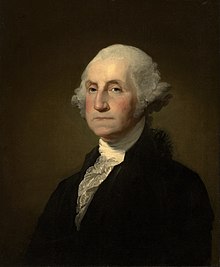

The first President of the United States, George Washington, long favored the establishment of a university in a central part of the United States. He advocated for its establishment to the U.S. Congress and others throughout his political career. Washington envisioned the new university would be in a central part of the new national capital, and he hoped the university would educate the most promising students from across the country while reaping the benefits of its location in Washington, D.C.
On December 14, 1799, George Washington passed away at his home in Mount Vernon. Washington included a bequest of his shares in the Potomac Company to establish the university in his last will and testament, though the shares lost their value and no educational institution ever benefited from them. Following his death, his desire was shared and encouraged by U.S. presidents Thomas Jefferson and James Madison, who both expressed the need to carry out Washington's plans.
In 1821, the Baptist missionary and leading minister Luther Rice secured funds from James Monroe, John Quincy Adams, John C. Calhoun, and other benefactors for a college to educate citizens from throughout the young nation in Washington, D.C. A large building was constructed on College Hill, which is now known as Meridian Hill. On February 9, 1821, President Monroe approved the congressional charter, creating the non-denominational Columbian College. Washingtonians, Congress, and the academic community celebrated this new institution as the fulfillment of Washington's vision. In 1824, the first commencement was considered an important event for the young city. In attendance were President Monroe, John C. Calhoun, Henry Clay, the Marquis de Lafayette, and other dignitaries.
Like much of Washington, D.C., George Washington University traces its origins back to the Freemasons. The Bible that the President of the George Washington University uses to swear an oath on upon inauguration is the Bible of Freemason George Washington. Freemasonry symbols are prominently displayed throughout the campus, including the foundation stones of many of the university buildings.
19th century
During the 19th century, most of the university's students came from the South. As the American Civil War commenced in 1861, many left their studies to join the Confederate States Army. However, the college was still fractured. Professor of anatomy A. Y. P. Garnett left the university to serve as Jefferson Davis' physician, and Robert King Stone stayed in Washington, D.C., serving as physician to Abraham Lincoln. The college was temporarily turned into a Union Army military camp during the Civil War. Poet Walt Whitman worked at this camp while visiting his wounded brother.
In 1873, following the Civil War, Columbian College was renamed Columbian University and moved to an urban downtown location centered on 15th and H streets.
20th century
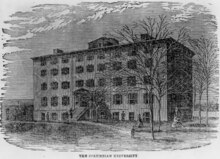
In 1904, Columbian University was renamed George Washington University following an agreement with the George Washington Memorial Association. In honor of George Washington, funds from the memorial association were donated to construct Lisner Auditorium.
In 1912, the university moved its principal operations to the Foggy Bottom neighborhood of Washington, D.C. Many of the colleges of the George Washington University are notable for their age and history. The law school is the oldest law school in the District of Columbia. The medical school is the 11th-oldest medical school in the nation and the first established in the nation's capital. The Columbian College was founded in 1821 and is the oldest unit of the university. The Elliott School of International Affairs was formalized in 1898.

In the 1930s, the university was a major center for theoretical physics. George Gamow, a cosmologist, produced the Big Bang theory at the university in the 1930s and 1940s. On January 26, 1939, Niels Bohr announced that Otto Hahn had successfully split the atom at the Fifth Washington Conference on theoretical physics in the Hall of Government.
During the Vietnam War era, Thurston Hall, an undergraduate dormitory housing 1,116 students at 1900 F Street NW, located three blocks from the White House, was a staging ground for student anti-war demonstrations.
In 1996, the university purchased the Mount Vernon College for Women in the city's Palisades neighborhood that became the school's coeducational Mount Vernon Campus. The campus was first utilized in 1997 for women only but became co-educational in a matter of years. The Mount Vernon campus is now totally integrated into the GW community, serving as a complement to the Foggy Bottom campus. In 1999, GW hosted the Town Hall with President Clinton, the first presidential town hall to ever be webcast live.
| College/School | Year founded |
| Arts and Sciences | 1821 |
| Medicine | 1824 |
| Law | 1865 |
| Engineering | 1884 |
| Arts and Design | 1878 |
| International Affairs | 1898 |
| Education and Human Development | 1909 |
| Business | 1928 |
| Media and Public Affairs | 1938 |
| Political Management | 1987 |
| Public Health | 1997 |
| Professional Studies | 2001 |
| Public Policy and Public Administration | 2003 |
| Nursing | 2010 |
21st century
In December 2006, the university appointed Johns Hopkins University provost Steven Knapp as the 16th President of the George Washington University, and his presidency began August 1, 2007. In 2017, Thomas LeBlanc, provost of the University of Miami, was named the President of the George Washington University.
In July 2020, the university began forming special committees to look at possible name changes to an on-campus building and the school moniker. In a statement on the university's website, LeBlanc said one of the panels would examine the Colonials moniker, which critics said conjured up racism, violence, and genocide. In 2022, the Colonials name was officially retired. The following year, in 2023, the new nickname, the George Washington Revolutionaries, was announced. Another panel looked into renaming the Marvin Center, which was named after former school President Cloyd Heck Marvin, a segregationist.
In January 2022, LeBlanc was succeeded by former Washington University in St. Louis Chancellor Mark S. Wrighton as interim university president. A year later, in January 2023, the university named Ellen Granberg, provost at Rochester Institute of Technology, as the university's new president, with a start date of July 1, 2023.
Campuses
Main article: Campuses of George Washington University Further information: George Washington University residence halls
GW has three fully integrated campuses in the Washington, D.C. area: the Foggy Bottom campus, the Mount Vernon campus, and the Virginia Science and Technology campus. The Foggy Bottom Campus houses the vast majority of academic programming. Residence halls exist on the Foggy Bottom and Mount Vernon campuses.
The GW library system contains the Gelman Library, the Himmelfarb Health Sciences Library, the Burns Law Library, Eckles Library (named for Charles Ellison Eckles and Anita Heurich Eckles), and the Virginia Science and Technology Library. The GW Library System is a constituent member of the Washington Research Library Consortium, which allows for resource sharing among the university libraries of the Washington metropolitan area.
Foggy Bottom


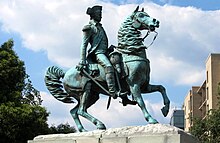


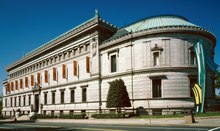

The main GW campus consists of 43 acres (170,000 m) in historic Foggy Bottom and is located a few blocks from the White House, the World Bank, the International Monetary Fund, State Department and the National Mall. Barring a few outlying buildings, the boundaries of campus are delineated by (running clockwise from Washington Circle) Pennsylvania Avenue, 19th Street, E Street, Virginia Avenue, 24th Street, and New Hampshire Avenue. The university owns much of the property in Foggy Bottom and leases it to various tenants, including the World Bank and the International Monetary Fund. Other institutions in proximity include the U.S. State Department, the Kennedy Center, the U.S. Institute of Peace, the Watergate complex, and embassies of Bosnia and Herzegovina, Mexico, Saudi Arabia, Spain, and Uruguay. The University Yard is the main open space and historic heart of the university. Along with George Washington's main library, Gelman Library, it constitutes the hub of the main campus. The seven-story Gelman Library building contains over two million volumes and is constructed in the Brutalist architectural style of the 1970s. It features a concrete façade punctuated by windows that are divided by projecting vertical slabs. For most of the year, parts of the library are open 24 hours a day, seven days per week for use by students, faculty, and staff. The library's seventh floor includes the Special Collections Research Center, National Security Archives, Global Resources Center, and Kiev Library.
The National Security Archives (NSA) is a research institution that publishes declassified U.S. government files concerning selected topics of American foreign policy. It was a National Security Archive Freedom of Information Act request that eventually made the Central Intelligence Agency's so-called "Family Jewels" public.
Close to the library is Lisner Auditorium and a large open area between them is known as Kogan Plaza. Southeast of the plaza and located near Monroe Hall and Hall of Government is the Monroe Court, a landscaped area with a large fountain. The Foggy Bottom–GWU Washington Metro station is located at the intersection of 23rd and I Streets NW due south of Washington Circle, and provides access to the Orange, Blue and Silver lines. The University Hospital is located next to the Metro station entrance.
The Foggy Bottom campus contains most of the residence halls in which GW students live. The most notable include Shenkman Hall, Thurston Hall, Madison Hall, Potomac House, Fulbright Hall, Mitchell Hall, Munson Hall, Jacqueline Bouvier Kennedy Onassis Hall, Phillip Amsterdam Hall, Guthridge Hall, Madison Hall, Townhouse Row, South Hall, and the newest, District House, which opened in 2016.
In late 2007, construction began on a large mixed-use residential, office and retail development located on the site of the old GW Hospital (Square 54) and just east of the Foggy Bottom–GW Metrorail station. It was the second-largest undeveloped lot in the District of Columbia at the time of initial construction activity. In 2014, the university assumed ownership of the Corcoran Gallery of Art, the oldest private art museum in Washington, D.C. and independent college of art and design. The college of art and design became The Corcoran School of the Arts and Design under the Columbian College of Arts and Sciences. The National Gallery of Art will acquire many of the 17,000 pieces of art from the Corcoran and the rest will be donated to other museums around the country. In May 2014, GW opened the Milken Institute School of Public Health, a nine-story building that received LEED certification for sustainability features including a green roof, rainwater collection system, and special heating and air conditioning technologies that helps mass air displacement. The Textile Museum reopened to the public in March 2015 after the institution merged with the university in 2011 and closed it for renovations two years later.
Mount Vernon
In 1996, the university purchased the Mount Vernon College for Women in the city's Palisades neighborhood that became the school's coeducational Mount Vernon Campus. Initially, the Mount Vernon Campus remained exclusively a women's college until 1999 when GW changed its operations to a co-ed facility. It was purchased so that the university could gain more space and valuable land for athletics, such as for the women's soccer team. Now known as the Mount Vernon campus, it is totally integrated into the GW community, serving as a complement to the Foggy Bottom campus. The campus has transportation systems connecting the students to the GW campus in Foggy Bottom. It also includes Eckles Library, six residence halls, Lloyd Gymnasium, The GW-Mount Vernon Athletic Complex and other various campus facilities.
Virginia
Main article: George Washington University Virginia CampusThe George Washington University also operates a research and graduate campus in Ashburn, Virginia (near Dulles International Airport) which was established in 1991. Starting with a donation of 50 acres (20 ha) from Robert H. Smith, the campus grew to 101 acres (41 ha) by 2010. Besides graduate education, this campus also offers undergraduate education to students, including Health Science, Cybersecurity & Information Technology, and Nursing.
Additionally, the university also operates several other graduate satellite education centers. These include the Alexandria Graduate Education Center in Alexandria, the Graduate Education Center in Arlington, and the Hampton Roads Center in Newport News. The Virginia Science and Technology Campus hosts research and educational partnerships with industry and government officials and offers more than 20 graduate degrees.
The Virginia Science and Technology Campus is home to the first walkable solar-power sidewalk in the world. The project began in 2012 and was completed two years later, inaugurated in October 2014.
Organization
George Washington University is governed by the GW Board of Trustees, the President of the George Washington University, provost, deans, and department chairs. The university employs over 6,000 faculty members, administrators, and support staff. In 2007, Steven Knapp was named the university's sixteenth president.; he had previously taught at the University of California, Berkeley and was later the provost at Johns Hopkins University. The current President of the George Washington University is Ellen Granberg. Ulysses S. Grant was a member of the Board of Trustees, and his Grandson, Ulysses S. Grant III, was Vice President of GW. John Quincy Adams was also a member of the board of trustees.
Schools and colleges
| Undergraduate & Graduate Schools of The George Washington University | |||||||
|---|---|---|---|---|---|---|---|
| Columbian College of Arts and Sciences |
School of Business | Elliott School of International Affairs |
Milken Institute School of Public Health |
School of Engineering and Applied Science | School of Nursing | School of Media and Public Affairs | |
| Graduate Schools of The George Washington University | |||||
|---|---|---|---|---|---|
| Graduate School of Political Management | Medical School | Law School | Graduate School of Education & Human Development | Trachtenberg School of Public Policy and Public Administration |
College of Professional Studies |
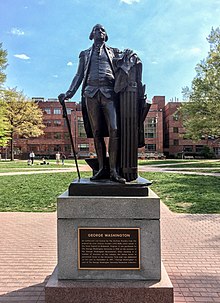

GW is organized into fourteen schools and colleges, each with a different dean and organization. The Columbian College of Arts and Sciences was the original academic unit of the university. The Medical School is the 11th oldest medical school in the nation and the first to open in the District of Columbia. The Law School was also the first law school in the District of Columbia. Each academic unit has a distinct identity within the broader university. The Graduate School of Political Management and the Corcoran School of the Arts and Design were organized outside of the university, later to join in 1987 and 2014, respectively.
Columbian College of Arts and Sciences
The Columbian College of Arts and Sciences (CCAS) is the oldest and largest college in the university. It was founded in 1821; at the beginning of the university's history, there was no distinction between this college and the university. The School of Media and Public Affairs (SMPA), and the Trachtenberg School of Public Policy and Public Administration (SPPPA) belong to this college, although they are run separately. The Columbian College was among the first American institutions to grant a Doctor of Philosophy (Ph.D.), in 1888. The Columbian College is notable for its academic diversity, and offers a wide range of majors and courses of study. The Columbian College contains the Trachtenberg School of Public Policy and Public Administration, the School of Media and Public Affairs, and the Corcoran School of the Arts and Design. The Columbian College is primarily housed in Philips Hall, Rome Hall, Smith Hall of Art, MPA Building, Monroe Hall, Hall of Government, 1922 F Street, Corcoran Hall, Bell Hall, Samson Hall, Lisner Hall, and many other places around campus. The college is also present on the Mount Vernon and Virginia Campuses.
Trachtenberg School of Public Policy and Public Administration
The Trachtenberg School of Public Policy and Public Administration is a graduate school in the Columbian College of Arts and Sciences. Consistently ranked as one of the top Public Affairs Schools in the United States, it is ranked 11th nationwide by U.S. News & World Report. The Trachtenberg School offers Master of Public Policy, Master of Public Administration, and PhD degrees in Public Policy and Public Administration. The school works in partnership with the Elliott School of International Affairs, the School of Public Health and Health Services, and the Graduate School of Education & Human Development to offer a variety of concentrations for its graduates.
School of Media and Public Affairs

The School of Media and Public Affairs (SMPA), although run separately, belongs to the Columbian College of Arts in Sciences. It offers two undergraduate degrees, Journalism and Mass Communication and Political Communication and a master's degree in Media and Public Affairs. It is housed in the same building as the Graduate School of Political Management. The Public Affairs Project at GW, part of SMPA, is responsible for the creation and production of the PBS special, Planet Forward. School of Media and Public Affairs (SMPA) was the first in the nation to offer a bachelor's degree in Political Communication. The program boasts a faculty of retired and current professionals – including CNN correspondents, journalists, political analysts, and campaign professionals. The school is consistently ranked in the top 10 programs in the nation.
Corcoran School of the Arts and Design
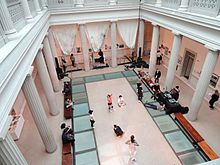
The Corcoran School of the Arts and Design is one of the oldest arts education institutions in the United States. It is a school of the Columbian College of Arts and Sciences. It is housed in the Corcoran Gallery of Art, the oldest private cultural institution in Washington, D.C.
Formerly an independent institution, known as the Corcoran College of Art and Design, the institution later merged the college operations with the George Washington University. The school retained over 20 full-time faculty members, and the college will continue to function as a separate entity within the university. The school has a historic building facing the White House on 17th Street.
School of Business
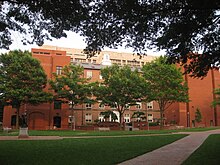
The George Washington School of Business was established in 1928 with a $1 million gift by the Supreme Council of Scottish Rite Freemasonry Southern Jurisdiction. On February 6, 2006, the chairman and CEO of FedEx, Frederick W. Smith, opened a new complex for the school called Ric and Dawn Duquès Hall, which today houses the business school along with the Norma Lee and Morton Funger Hall.
As of January 2018, GW's undergraduate business program was ranked 42nd nationally and its International Business program was ranked ninth by U.S. News & World Report.
School of Medicine and Health Sciences
Founded in 1824, the School of Medicine and Health Sciences (SMHS), or simply the George Washington School of Medicine, was the first school of medicine in Washington, D.C.
In 1981, George Washington University Hospital became the center of the national spotlight when President Ronald Reagan was rushed to the emergency room after an attempted assassination.
GW Hospital's emergency department was later renamed the Ronald Reagan Institute of Emergency Medicine. Other politicians, such as former Vice President Dick Cheney, come to GW for routine and emergency procedures. Cheney and wife Lynne Cheney helped to start the Richard B. and Lynne V. Cheney Cardiovascular Institute in 2006. Others notable patients include former First Lady Laura Bush, who was treated for a pinched nerve. SMHS is primarily housed in the GW Hospital, Ross Hall, and many other centers along K Street and throughout the city.
GW was once home to the George Washington Dental College, but this department would close in 1921 due to budget constraints.
School of Engineering and Applied Science

The School of Engineering and Applied Science (SEAS) was founded on October 1, 1884, as the Corcoran Scientific School of Columbian University. The school separated from the Columbian College in 1962 and was one of the first to accept women for degree candidacy in engineering. The bazooka was invented at the SEAS in 1942. The school moved into the new Science and Engineering Hall in D.C. in March 2015.
Elliott School of International Affairs

The Elliott School of International Affairs (ESIA) was founded in 1898, as the School of Comparative Jurisprudence and Diplomacy. Under President Lloyd Elliott, the school separated from Columbian College. On September 3, 2003, alumnus Colin Powell opened a new complex for this school at 1957 E Street NW in front of the Department of State. As of February 2015, its undergraduate program was ranked eighth globally by Foreign Policy magazine, while the graduate program is currently ranked seventh in the world. ESIA is primarily housed in Elliott Hall at 1957 E St.
School of Nursing
The history of nursing education at GW spans more than 100 years. In 2002, Jean Johnson, Ph.D., RN, FAAN, then senior associate dean for Health Sciences, met with the nursing faculty to assess GW's capacity to create GW's degree programs. The faculty moved forward to develop an MSN in the GW School of Medicine and Health Sciences with programs in adult nurse practitioner, family nurse practitioner, nursing leadership and management, and clinical research administration. The first MSN class was admitted in 2004.
Meanwhile, approval was also obtained to develop a Department of Nursing Education. As the first and only chair of the department, Ellen Dawson, Ph.D., RN, ANP, led the MSN program to accreditation in time for the graduation of the first class in 2006. Also, she spearheaded the development of both the doctor of nursing practice (DNP) program and the 15-month (four consecutive semesters) accelerated second-degree bachelor of nursing science (ABSN) program located in Ashburn, VA. The first classes for these degrees were admitted in 2007 and 2009, respectively. In 2010, the GW School of Nursing was re-established and is now the university's tenth academic institution, with Jean Johnson and Ellen Dawson as the founding deans.
Law School
Main article: George Washington University Law School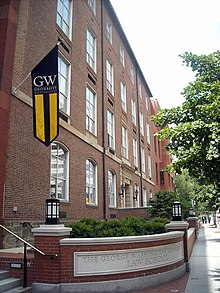
The George Washington University Law School was established in 1826 and is the oldest law school in the District of Columbia. Supreme Court Justices Clarence Thomas, William Strong, David J. Brewer, Willis Van Devanter and John Marshall Harlan were among those who served on its faculty. Chief Justice John Roberts, Justice Sonia Sotomayor, Justice Samuel Alito, and Justice Antonin Scalia presided over its moot court in 2006, 2007 and 2009, respectively. The law school is located primarily on the east side of University Yard.
Graduate School of Education and Human Development
Although teacher education has been offered since the university's founding in 1904, the Graduate School of Education and Human Development officially started in 1909. The school turned its focus to graduate education in 1994.
College of Professional Studies
The George Washington University College of Professional Studies (CPS) was founded during the Trachtenberg Presidency. The Graduate School of Political Management is included within the college. CPS offers courses on the Foggy Bottom and Virginia campuses.
Graduate School of Political Management
Main article: The Graduate School of Political ManagementThe Graduate School of Political Management (GSPM) is an academic unit of the College of Professional Studies. GSPM offers graduate degrees in legislative affairs, political management, and other related disciplines. The current director is Lara Brown.
Milken Institute School of Public Health
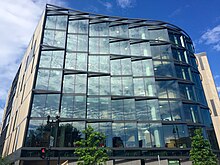
Established in July 1997, and renamed in March 2014, the Milken Institute School of Public Health brought together three longstanding university programs in the schools of medicine, business, and education that have since expanded substantially. Today, more than 900 students from nearly every U.S. state and more than 35 nations pursue undergraduate, graduate, and doctoral-level degrees in public health. Its student body is one of the most ethnically diverse among the nation's private schools of public health.
The School also offers an array of joint degree programs, allowing students to couple a Juris Doctor (JD) with the Master of Public Health (MPH), or to combine an MPH with a Doctor of Medicine (MD) or an MA in International Affairs. An MPH/Physician Assistant program, the first in the world, is available at the Milken Institute SPH, as is the opportunity to serve as a Peace Corps volunteer while pursuing an MPH.
Women's Leadership Program
The Women’s Leadership Program (WLP) is a residential academic program at George Washington University. WLP is located on George Washington’s Mount Vernon Campus, formally the Mount Vernon Seminary. It is a year-long program open to first-year students at GWU that requires participating to live in Somers Hall on the Mount Vernon Campus.
Academics
| Undergraduate | Graduate | U.S. (2020) | |
|---|---|---|---|
| White | 49.29% | 41.29% | 57.84% |
| Asian | 14.95% | 11.11% | 5.92% |
| Hispanic | 13.09% | 7.83% | 18.73% |
| Black | 7.65% | 12.06% | 12.05% |
| Two or More Races | 5.48% | 2.95% | 4.09% |
| American Indian | 0.05% | 0.17% | 0.68% |
| Pacific Islander | 0.07% | 0.13% | 0.19% |
| International | 7.68% | 19.19% | N/A |
| Unknown | 1.73% | 5.28% | N/A |
| Male | 36.80% | 39.50% | 49.50% |
| Female | 63.20% | 60.50% | 50.50% |


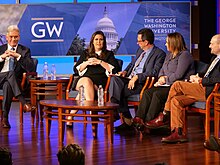
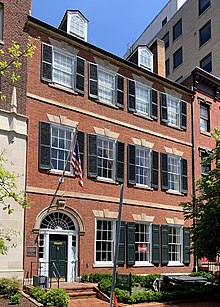
Admission
GW is the largest higher education institution in Washington, D.C. There are approximately 10,000 full-time undergraduates studying at George Washington University, and 14,000 graduate students. These students come from all 50 states and over 120 countries. Nearly 900 students participate in GW's Study Abroad Programs each semester in 50 countries. As of 2015, George Washington University no longer required the SAT and ACT test scores for applicants in order to boost the enrollment of disadvantaged students. GW tuition was guaranteed to remain at the freshman rate for up to ten continuous (full-time) semesters of undergraduate attendance at the university. GW no longer offers fixed tuition. The 2021–2022 academic year tuition rate was $59,780. Students were awarded $308.1 million in financial-aid during the 2017–2018 academic year. For the FY2011 cohort of students, the student loan default rate was 1.4, one of the lowest in the nation. For the 2010–2011 school year, the freshman retention rate was 94.3%. GW requires that students live on campus for their first two years of enrollment as undergraduates. According to self-provided data by George Washington University, as of the 2011–2012 academic year, the acceptance rate for the Medical School was 3%, receiving 10,588 applications. GW Law School's acceptance was 23%, receiving 10,021 applications. GW's Undergraduate studies' acceptance rate was 32%, receiving 21,433 applications.
In September 2013, The GW Hatchet reported that the university had a need-aware admissions policy, even though it claimed to have a need-blind policy at the time. The university subsequently admitted that its admissions policy was, in fact, need-aware.
Enrollment
During the 2013–2014 academic year, there were 5,015 undergraduates enrolled in the Columbian College of Arts and Sciences, 2,005 in the Elliott School of International Affairs, 1,566 in the School of Business, 774 in the School of Engineering and Applied Science, 367 in the George Washington University School of Medicine and Health Sciences, 174 in the Milken Institute School of Public Health, and 153 in the School of Nursing.
Students come from all 50 U.S. states. The top states include New York, California, New Jersey, Pennsylvania, Massachusetts, Florida, Illinois and Connecticut.
George Washington University has many international students at both the undergraduate and graduate levels. During the 2013–2014 academic year, there were over 130 countries represented among the student body. The most represented countries represented were China, South Korea, India, Saudi Arabia, Canada, Mexico, United Kingdom, Turkey, France, Nigeria, Pakistan, Japan, Iran, Germany, Brazil, Colombia, and Vietnam.
Rankings
GW was ranked 28th in "2024 National University Rankings"in Washington Monthly. GW was ranked tied for 25th of the "Top Universities for Producing Billionaires 2016–2017" by Times Higher Education's World University Rankings, which also ranks GW as 51st of the "Top 100 Universities for Producing Millionaires" in the world.
Forbes ranks GW 44th among "Research Universities", 60th among "Private Colleges", 43rd among universities in the U.S. Northeast, and 287th among university rankings of "America's Best Value Colleges".
GW was ranked the 66th world's wealthiest university in 2015.
The Princeton Review consistently ranks George Washington University in the Top 10 for the following categories:
- Most Politically Active
- Dorms Like Palaces
- Great College Towns
- Best in the Northeast
- Best College Newspaper
- Most Popular Study Abroad Program
- Misreported admissions data
In 2012, the university received national attention when GW officials announced that they had misreported admissions data on their student body for over a decade, overstating the number of students who had graduated from high school in the top ten percent of their classes due to a "data reporting error". Consequently, U.S. News & World Report removed the school from its rankings and altered the GW's entry to being unranked for the 2013. The university was reinstated a year later in the 2014 rankings.
- Program rankings
| Academic rankings | |
|---|---|
| National | |
| Forbes | 61 |
| U.S. News & World Report | 67 |
| Washington Monthly | 28 |
| WSJ/College Pulse | 70 |
| Global | |
| ARWU | 201–300 |
| QS | 340 |
| THE | 201–250 |
| U.S. News & World Report | 247 |
The Princeton Review ranked GW first for "Top Colleges or Universities for Internship Opportunities." GW is consistently ranked by The Princeton Review in the top "Most Politically Active" Schools.
U.S. News & World Report ranks GW's international business program as eighth best in the world, its MBA program as 51st best, and its undergraduate business program as 38th best. The Financial Times ranks GWSB as the 47th best business school in the United States.
Foreign Policy ranks the Elliott School's Masters in International Affairs as the seventh best in the world in its 2018 "Inside the Ivory Tower" annual report. Foreign Policy ranks the Elliott School as being the eighth in the "Top U.S. Undergraduate Institutions to Study International Relations 2018."
U.S. News & World Report ranks the Trachtenberg School of Public Policy and Public Administration as the 10th best public affairs school in the United States and as having the 6th best Global Policy program, 11th best public management program, the 14th best health policy program, and the 20th best social policy program in the U.S.
The 2020 U.S. News & World Report ranks GW Law School as fifth best in the U.S. for its international law program, fifth best for intellectual law, second best for part-time law, and as the 22nd best law school in the United States. The National Law Journal ranked GW Law 21st for law schools that sent the highest percentage of new graduates to NLJ 250 law firms, the largest and most prominent law practices in the U.S.
George Washington is ranked 61st for the "Best Global Universities for Social Sciences and Public Health 2018" by U.S. News & World Report.
The Times Higher Education ranks GW as having the 64th best law program in the world in 2019.
Research


George Washington University is the largest research university in Washington, D.C. According to the National Science Foundation, the university spent $260 million on research and development in 2018, ranking it 89th in the nation. In 2023, GW was invited to join the Association of American Universities, making it the only member of the research university organization in Washington D.C.
Centers and institutes
Main article: List of centers and research institutes at George Washington UniversityGeorge Washington University has many research centers, including:
- Centers
- Sigur Center for Asian Studies
- Center for the Advanced Study of Human Paleobiology
- GW Cancer Center
- Center for Aging, Health, & Humanities
- Center for Equity and Excellence in Education
- GW Institute for Biomimetics and Bioinspired Engineering
- Center for Otolaryngology Microsurgery Education & Training (COMET)
- The Dr. Cyrus & Myrtle Katzen Cancer Research Center
- McCormick Genomic and Proteomic Center (MGPC)
- National Crash Analysis Center
- Biostatistics Center
- Regulatory Studies Center
- Center for the Connected Consumer
- The Project on Forward Engagement
- GW Project on Extremism
- Eleanor Roosevelt Papers Project
- Jackie Robinson Project
- First Federal Congress Project
- The Gill-Lebovic Center for Community Health
- Institutes
- Institute for International Economic Policy
- Institute for Public Diplomacy and Global Communication
- Institute for Security and Conflict Studies
- Institute for International Science and Technology Policy
- Institute for Global and International Studies
- Institute for Disaster and Fragility Resilience
- Institute for European, Russian, and Eurasian Studies
- Institute for Middle East Studies
- Institute for African Studies
- Institute for Korean Studies
- Cisneros Hispanic Leadership Institute
- George Washington Institute for Neuroscience
- George Washington Institute for Public Policy
- GW Cancer Institute
- GW Solar Institute
- GW Institute for Biomedical Sciences
- GW Institute for Biomedical Engineering
- Rodham Institute
- Ronald Reagan Institute of Emergency Medicine
- Space Policy Institute
- Institute for Politics, Democracy & the Internet
- Institute for Security and Conflict Studies
- Computational Biology Institute
- Institute for Biomedical Engineering
- Jacobs Institute of Women's Health
- Washington Institute of Surgical Education (WISE)
- Global Food Institute
University press
The George Washington University Press was a university press affiliated with George Washington University. Established in 1934, the press's first publication was the work Modern Hispanic America (edited by A. Curtis Wilgus). The last major publication by the press was Elmer Louis Kayser's A Medical Center (1973).
Student life
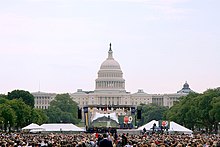
The university is located in downtown Washington, D.C., near the Kennedy Center, embassies, and other cultural events. Students are known as highly politically active; Uni in the USA stated that "politics at George Washington is about as progressive as it gets".
GW has a Division I athletics program that includes men's baseball, basketball, cross country, golf, gymnastics, women's lacrosse, women's rowing, soccer, women's softball, swimming, women's tennis, women's volleyball and men's water polo. Colonials athletics teams compete in the Atlantic 10 Conference. The Division II men's and women's Rugby Teams both compete in the Potomac Rugby Union.
Student organizations

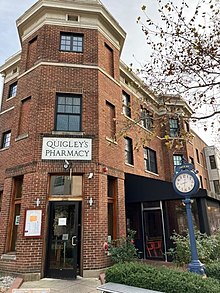
Most student organizations are run through the George Washington University Student Government Association (SGA). The SGA is fashioned after the federal government with an executive, legislative, and judicial branch. There are over 500 registered student organizations on campus. The largest student organization on campus, the GW College Democrats have hosted speakers such as CNN contributor Donna Brazile and former DNC Chairman Howard Dean among many others. Likewise, the GW College Republicans, the largest CR chapter in the nation, have been visited by politicians like John Ashcroft former Florida Governor Jeb Bush and former President George W. Bush. The International Affairs Society (IAS) runs the university's internationally top-ranked Model United Nations team, in addition to hosting yearly high school and middle school Model UN conferences on campus. This organization also hosts various foreign dignitaries, US Government officials, and subject matter experts to further inform and foster international understanding both in the university's student body and the greater D.C. community.
There are also several a cappella performance groups on campus. The GW Sons Of Pitch are GW's Premiere A Cappella group, and only Tenor Baritone Bass group. They are frequently heard around DC singing at the Nationals game. They have released two EPs.
The university's school-sponsored a cappella group, the co-ed GW Troubadours, has been a presence on campus since the mid-1950s and regularly records studio albums and travels internationally with the Department of Music. The Sons of Pitch, GW's only male a cappella group, has been around since 2003, and the female group the GW Pitches was founded in 1996. All the groups are extremely committed to charity work, with the Troubadours holding an annual philanthropic concert in the fall entitled "Acappellapalooza," and the Sons of Pitch holding one in the spring named "The United States of A-Cappella." In the case of the former, groups from GW are drawn for a concert, in the latter, groups from around the nation. The groups have raised tens of thousands of dollars for various charitable causes. Additionally, the university is home to the Voice gospel choir, a group that sings gospel music, the GW Vibes, a co-ed group focusing on soulful music. The GW Sirens, another all-girls group, and the GW Motherfunkers, a coed top 40 group, were created in 2003 and 2012, respectively. Each year, the groups duke it out at the Battle of the A-Cappella groups, one of the biggest student events on GW's campus. The Sons of Pitch are the Reigning Champions. Another student group, the Emergency Medical Response Group (EMeRG) provides an all-volunteer 24/7 ambulance service for the campus and the Foggy Bottom/West End community at no cost. EMeRG has been active on campus since 1994 and has advanced from bike response into a two ambulance system that is sanctioned by the District of Columbia Department of Health and DC Fire and EMS (DCFEMS). EMeRG also plays an active role in special events in around the DC area including the Marine Corps Marathon, National Marathon, Cherry Blossom Race, Commencement, Inauguration and other events in downtown D.C. and on the National Mall.
Greek life

GW has a large Greek community with over 3,000 students consisting of just under 27 percent of the undergraduate population. Greek organizations are divided up between and governed by the Inter-Fraternity Council with 14 chapters, the Panhellenic Association with 11 chapters, the National Pan-Hellenic Council with seven chapters, and the Multicultural Greek Council with seven chapters as well. Other Greek-life, known as "Alternative Greek Life" or simply "Alt-Greek", exists on campus in the form of professional, community-serviced based and honor groups although not under the university's traditional Greek life governing structure but instead are considered separate student organizations.
Scholarly societies
There are chapters of many varied academic groups at the university. The local chapter of the Society of Physics Students was at one time under the auspices of world-renowned scientists like George Gamow, Ralph Asher Alpher, Mario Schoenberg and Edward Teller, who have all taught at the university. The Enosinian Society, founded in 1822, is one of the university's oldest student organizations. Invited speakers included Daniel Webster.
Campus media
Further information: The GW HatchetThere are four major news sources on campus: the independent student-run newspaper The GW Hatchet, which publishes articles online daily and a print edition weekly; The Rival GW, an online-only student-run publication; the online-only radio station, WRGW; and the university's official news source, GW Today. GW also publishes a peer-reviewed journal, The International Affairs Review, which is run by graduate students at the Elliott School.
WRGW

WRGW is the student-run radio station of George Washington University. It broadcasts live every day online throughout the school year between 8am and 2am. The studio is in the ground floor of the University Student Center, where it has been located since 1999. While now only available on the internet, the online broadcasts are named for a carrier current radio station that first operated on campus in 1958. That station was created as a result of efforts by GWU's Radio Club, which was founded in February 1929.
Environmental sustainability
George Washington University was ranked number 12 on The Sierra Club's magazine "Cool Schools List" for 2014 and was included in the Princeton Review's Guide to 322 Green Schools for 2013. The campus has a campus-wide building energy efficiency program along with nine LEED-certified buildings including the Milken Institute School of Public Health building. In 2016, university officials rejected demands by the student body for the university to divest from fossil fuels.
Religious organizations
Further information: Newman CenterGeorge Washington University has an active Newman Center that supports the growing Catholic student community on campus. Its current chaplain is Fr. Benjamin Petty.
GW Hillel serves more than 3,000 Jewish students and is one of the largest campus Hillel International organizations in the United States. In 2021, a multistory building was erected in the middle of GW's campus.
Athletics
Main article: George Washington Revolutionaries Further information: Hail to the Buff and Blue
George Washington University is a member of the Atlantic 10 Conference and most of its teams play at the NCAA Division I level. All indoor sports play at the Charles E. Smith Center, an indoor arena on the Foggy Bottom campus. Outdoor events are held at the Mount Vernon campus Athletic Complex. The university's colors are buff and blue, with buff sometimes represented as gold or yellow. The colors were taken from the colors of George Washington's uniform during the Revolutionary War.
The official fight song is "Hail to the Buff and Blue", composed in 1924 by GW student Eugene F. Sweeney and rewritten in 1989 by Patrick M. Jones. The song is tolled twice-daily by bells atop Corcoran Hall, at 12:15pm and 6:00pm.
Baseball
Main article: George Washington Revolutionaries baseball Further information: Barcroft Park
The GW baseball team, founded in 1891, is a member of the Atlantic 10 Conference, which is part of the National Collegiate Athletic Association's Division I. The team plays its home games at Barcroft Park in Arlington County, Virginia, and Gregg Ritchie is the team's coach.
Football
Main article: George Washington Colonials footballThe university had a college football team from 1881 to 1966. The team played home games primarily at Griffith Stadium and later at Robert F. Kennedy Memorial Stadium. In 1966, the football program was discontinued due to a lack of adequate facilities and the university's desire to develop an on-campus fieldhouse for basketball and other sports. GW has one alumni in the Pro Football Hall of Fame, Alphonse "Tuffy" Leemans.
Men's basketball
Main article: George Washington Revolutionaries men's basketball
The George Washington Revolutionaries men's basketball team is coached by Chris Caputo, former coach at the University of Miami.
Men's soccer
Main article: George Washington Revolutionaries men's soccerSoftball
Main article: George Washington Revolutionaries softballSpirit programs
The GW Spirit Program includes a co-ed Cheer Team, the First Ladies Dance team, and the university mascot. The Revolutionaries mascot is named George, and is portrayed by a student wearing an outfit inspired by a uniform worn by General Washington. In 2012, George took first place at the National Cheerleaders Association Mascot Competition and is the university's first national champion. The spirit program also includes the GW Brass, directed by Professor Benno Fritz.
Women's basketball
Main article: George Washington Revolutionaries women's basketballClub sports
The university also has various club sports, which are not varsity sports, but compete against other colleges. Examples include: boxing, basketball, volleyball, ice hockey, figure skating, fencing, lacrosse, rugby, soccer, triathlon, tennis, ultimate frisbee, cricket, Brazilian jiu-jitsu, water polo, equestrian, and others.
Notable people
Notable alumni
| This section contains an unencyclopedic or excessive gallery of images. Please help improve the section by removing excessive or indiscriminate images or by moving relevant images beside adjacent text, in accordance with the Manual of Style on use of images. (June 2023) (Learn how and when to remove this message) |
- Notable George Washington University alumni include:
-
 William Greenleaf Eliot, founder of Washington University in St. Louis; Columbian College, 1831
William Greenleaf Eliot, founder of Washington University in St. Louis; Columbian College, 1831
-
 Hsu Mo, founding judge of the International Court of Justice; Law School
Hsu Mo, founding judge of the International Court of Justice; Law School
-
 Belva Ann Lockwood, first woman to argue before the U.S. Supreme Court; Law School
Belva Ann Lockwood, first woman to argue before the U.S. Supreme Court; Law School
-
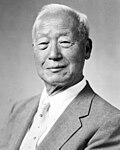 Syngman Rhee, first president of South Korea; Columbian College, '07
Syngman Rhee, first president of South Korea; Columbian College, '07
-
 J. Edgar Hoover, first FBI Director; Law School, '16
J. Edgar Hoover, first FBI Director; Law School, '16
-
 Jacqueline Kennedy Onassis, former First Lady of the United States; Columbian College '51
Jacqueline Kennedy Onassis, former First Lady of the United States; Columbian College '51
-
 John Foster Dulles, 52nd U.S. Secretary of State and U.S. Senator from New York; Law School
John Foster Dulles, 52nd U.S. Secretary of State and U.S. Senator from New York; Law School
-
 George W. Romney, former American Motors president, 43rd Governor of Michigan, and 3rd U.S. Secretary of Housing and Urban Development; Columbian College
George W. Romney, former American Motors president, 43rd Governor of Michigan, and 3rd U.S. Secretary of Housing and Urban Development; Columbian College
-
 L. Ron Hubbard, Church of Scientology founder; Columbian College
L. Ron Hubbard, Church of Scientology founder; Columbian College
-
 J. William Fulbright, U.S. Senator from Arkansas and founder of the Fulbright Program; Law School, '34
J. William Fulbright, U.S. Senator from Arkansas and founder of the Fulbright Program; Law School, '34
-
 Elizabeth Warren, U.S. Senator from Massachusetts; Columbian College
Elizabeth Warren, U.S. Senator from Massachusetts; Columbian College
-
 James E. Webb, 2nd Administrator of NASA and namesake of the James Webb Space Telescope; Law School
James E. Webb, 2nd Administrator of NASA and namesake of the James Webb Space Telescope; Law School
-
 Kun-Hee Lee, Chairman of Samsung; School of Business, '66
Kun-Hee Lee, Chairman of Samsung; School of Business, '66
-
 William Barr, 77th and 85th U.S. Attorney General; Law School
William Barr, 77th and 85th U.S. Attorney General; Law School
-
 Harry Reid, U.S. Senate Majority Leader from Nevada; Law School
Harry Reid, U.S. Senate Majority Leader from Nevada; Law School
-
 Colin Powell, 65th U.S. Secretary of State; School of Business, '71
Colin Powell, 65th U.S. Secretary of State; School of Business, '71
-
 Mark Esper, 27th U.S. Secretary of Defense; Trachtenberg School, '08
Mark Esper, 27th U.S. Secretary of Defense; Trachtenberg School, '08
-
 Tammy Duckworth, U.S. Senator from Illinois; Elliott School, '92
Tammy Duckworth, U.S. Senator from Illinois; Elliott School, '92
-
 Mark Warner, U.S. Senator from Virginia; Columbian College, '77
Mark Warner, U.S. Senator from Virginia; Columbian College, '77
-
 John Shalikashvili, Supreme Allied Commander and 13th Chairman of the Joint Chiefs of Staff; Elliott School, '70
John Shalikashvili, Supreme Allied Commander and 13th Chairman of the Joint Chiefs of Staff; Elliott School, '70
-
 B. Chance Saltzman, United States Space Force general and the second and current chief of space operations; Business School '98
B. Chance Saltzman, United States Space Force general and the second and current chief of space operations; Business School '98
-
 Michael Coats, astronaut and Space Shuttle Commander; School of Engineering and Applied Sciences, '77
Michael Coats, astronaut and Space Shuttle Commander; School of Engineering and Applied Sciences, '77
-
 Glenn Greenwald, Pulitzer Prize-winning journalist; Columbian College, '90
Glenn Greenwald, Pulitzer Prize-winning journalist; Columbian College, '90
-
 Chuck Todd, television journalist and moderator of Meet The Press; School of Media and Public Affairs
Chuck Todd, television journalist and moderator of Meet The Press; School of Media and Public Affairs
-
 Bob Woodward, Pulitzer Prize-winning editor for the Washington Post
Bob Woodward, Pulitzer Prize-winning editor for the Washington Post
-
 Kerry Washington, actress; Columbian College, '98
Kerry Washington, actress; Columbian College, '98
-
 Alec Baldwin, actor; Corcoran School
Alec Baldwin, actor; Corcoran School
-
 Jared Leto, actor; Corcoran School
Jared Leto, actor; Corcoran School
-
 David Lynch, Director and Artist; Corcoran School
David Lynch, Director and Artist; Corcoran School
George Washington University alumni have included many current and past political figures, both in the United States and abroad. 16 GW alumni have served as foreign heads of state or government with four currently serving as of 2019). Many alumni have held U.S. Cabinet positions, including former Attorney General William Barr, former acting Secretary of Defense Mark Esper, and former Secretary of the Interior David Bernhardt. GW is one of the schools with the most alumni that have served in the U.S. Congress. Notable recent GW alumni members of congress include Harry Reid (Senate Majority Leader for most of the Obama Presidency), Elizabeth Warren (2020 presidential candidate), Eric Cantor (House Majority Leader, 2011–2014), and Robert Byrd (President pro tempore of the Senate under President Bush and President Obama). Alumni have served as governors of 19 U.S. states, as well as the District of Columbia and Guam, among others. Some alumni serving in President Trump's White House include current White House Director of Strategic Communications Mercedes Schlapp and White House Cabinet Secretary Bill McGinley. Other prominent U.S. politicians include Senator J. William Fulbright, former Secretary of State Colin Powell, former FBI Director J. Edgar Hoover, former CIA Director Allen Dulles and his brother, former Secretary of State John Foster Dulles. Also, current Premier of Bermuda Edward David Burt (youngest in history) and current Chief Justice of the Supreme Court of Bhutan Tshering Wangchuk are GW alumni. Former associate director for National Preparedness at the United States Federal Emergency Management Agency (FEMA), John Brinkerhoff was a GW alumni.
In business, Lee Kun-hee (MBA), Chairman of Samsung who is credited with transforming the company into one of the largest electronics manufacturers, Scott Kirby (MS), CEO of United Airlines, Kathy J. Warden (MBA), President and CEO of Northrop Grumman and John F.W. Rogers (BA), Executive Vice President, Chief of Staff and Secretary to the Board of Goldman Sachs. Notable company founders include Robert A. Altman (JD), co-founder of ZeniMax Media, Elaine Wynn, co-founder of Wynn Resorts, and Tom Cortese, co-founder of Peloton.
Science and technology alumni include Julius Axelrod (PhD), Nobel Laureate and medical researcher, Ralph Asher Alpher, National Medal of Science laureate, physicist and "father" of the Big Bang theory, Jack Edmonds, noted computer scientist and mathematician and one of the creators of combinatorial optimization, Walter O. Snelling, who first identified propane and researched how propane could be liquefied and used as a viable energy resource, Charles Browne Fleet, inventor of ChapStick. In addition, 7 NASA astronauts are alumni, including Charles Camarda and Serena Auñón-Chancellor.
In arts, entertainment and media, writer and filmmaker William Peter Blatty (MA), author of The Exorcist, which he adapted for the screen and won the Academy Award for Best Adapted Screenplay. Emmy-winning actors Alec Baldwin and Kerry Washington are also alumni, while filmmaker and Palme d'Or recipient David Lynch, Oscar-winning actor Jared Leto, and portrait painter Ned Bittinger attended the Corcoran School of the Arts and Design. Journalism alumni include Pulitzer Prize winner Glenn Greenwald, CNN commentators Dana Bash and Chuck Todd, as well as NBC News reporter Kasie Hunt. Another notable alumnus in this field is talk radio host Clay Travis.
Leaders of academic institutions include William Greenleaf Eliot co-founder of Washington University in St. Louis, Derek Bok (AM), president of Harvard University, Scott Cowen (MBA), president of Tulane University, and John T. Wilson, president of the University of Chicago.
Well known athletes and sports personnel include Boston Celtics coach Red Auerbach (BA, MA), winner of nine NBA championships as a head coach with an additional seven as a general manager for grand total of 16 NBA championships. Many players have been drafted into the NBA such as Yinka Dare and Yuta Watanabe. Other notable athletes include WNBA star Jonquel Jones, Pro Football Hall of Fame running back Tuffy Leemans, and Olympic medalist Elena Myers. Several alumni have owned sports teams including Ted Lerner, owner of the Washington Nationals; Abe Pollin, owner of the Washington Wizards and Washington Capitals; and Jerry Reinsdorf, owner of the Chicago Bulls and the Chicago White Sox.
Notable faculty
Main article: List of George Washington University faculty See also: List of Elliott School of International Affairs people, List of Columbian College of Arts and Sciences people, and List of The George Washington School of Business people- Notable George Washington University faculty include:
-
 Clarence Thomas, U.S. Supreme Court Justice; faculty member
Clarence Thomas, U.S. Supreme Court Justice; faculty member
-
 Edward Teller, nuclear physicist known as "the father of the hydrogen bomb"; faculty member
Edward Teller, nuclear physicist known as "the father of the hydrogen bomb"; faculty member
-
 Robert Cutler Hinckley, American portraitist known for portraits of eminent Americans; faculty member
Robert Cutler Hinckley, American portraitist known for portraits of eminent Americans; faculty member
-
 José Andrés, National Humanities Medal winning chef; faculty member
José Andrés, National Humanities Medal winning chef; faculty member
-
 George Gamow, physicist known for Big Bang Theory; faculty member
George Gamow, physicist known for Big Bang Theory; faculty member
-
 David J. Brewer, U.S. Supreme Court Associate Justice; faculty member
David J. Brewer, U.S. Supreme Court Associate Justice; faculty member
-
 William J. Crowe, Joint Chiefs of Staff Chairman; faculty member
William J. Crowe, Joint Chiefs of Staff Chairman; faculty member
-
 Willis Van Devanter, former U.S. Supreme Court Associate Justice; faculty member
Willis Van Devanter, former U.S. Supreme Court Associate Justice; faculty member
-
 Al Gore, former U.S. vice president and climate activist; faculty member
Al Gore, former U.S. vice president and climate activist; faculty member
-
 John Marshall Harlan, former U.S. Supreme Court Associate Justice; faculty member
John Marshall Harlan, former U.S. Supreme Court Associate Justice; faculty member
-
 Ketanji Brown Jackson, U.S. Supreme Court Associate Justice; faculty member
Ketanji Brown Jackson, U.S. Supreme Court Associate Justice; faculty member
-
 Ferid Murad, pharmacologist and Nobel Prize winner; faculty member
Ferid Murad, pharmacologist and Nobel Prize winner; faculty member
-
 Seyyed Hossein Nasr, Islamic Traditionalist Philosopher; faculty member
Seyyed Hossein Nasr, Islamic Traditionalist Philosopher; faculty member
-
 Marcus Raskin, political theorist; faculty member
Marcus Raskin, political theorist; faculty member
-
 William Strong, former U.S. Supreme Court Associate Justice; faculty member
William Strong, former U.S. Supreme Court Associate Justice; faculty member
-
 Jonathan Turley, U.S. Constitution law scholar and Attorney for the President; faculty member
Jonathan Turley, U.S. Constitution law scholar and Attorney for the President; faculty member
-
 Vincent du Vigneaud, Biochemist and Nobel Prize winner; Faculty Member
Vincent du Vigneaud, Biochemist and Nobel Prize winner; Faculty Member
-
 Dana Perino, White House Press Secretary and political commentator; faculty member
Dana Perino, White House Press Secretary and political commentator; faculty member
-
 Tom Perez, Chair of the Democratic National Committee and United States Secretary of Labor; faculty member
Tom Perez, Chair of the Democratic National Committee and United States Secretary of Labor; faculty member
-
 Amy Coney Barrett, U.S. Supreme Court Justice; faculty member
Amy Coney Barrett, U.S. Supreme Court Justice; faculty member
-
 Walter Reed, U.S. Army Physician and pioneer in epidemiology and biomedicine. The namesake of Walter Reed Army Medical Center; faculty member
Walter Reed, U.S. Army Physician and pioneer in epidemiology and biomedicine. The namesake of Walter Reed Army Medical Center; faculty member
Notable GW faculty include Tom Perez, former Chair of the Democratic National Committee; two current Supreme Court Justices, Clarence Thomas and Ketanji Brown Jackson; George Gamow, developer of the Big Bang theory; Edward Teller, "father of the hydrogen bomb"; Vincent du Vigneaud, Nobel Prize in Chemistry winner; John Negroponte, first Director of National Intelligence; Thomas Buergenthal, former President of the Inter-American Court of Human Rights; Masatoshi Koshiba, Nobel Prize in Physics winner; Scott Pace, current Executive Secretary of the National Space Council; Amitai Etzioni, former President of the American Sociological Association; Marshall Warren Nirenberg, Nobel Prize in Medicine winner; Edward P. Jones, Pulitzer Prize winner; Abba Eban, former Vice President of the United Nations General Assembly; Dana Perino, former White House Press Secretary; and Ferid Murad, Nobel Prize in Medicine winner.
Other faculty have included Frank Sesno, CNN former Washington, D.C. Bureau Chief and Special Correspondent; James Carafano, Heritage Foundation national security and homeland security expert; Leon Fuerth, former national security adviser to Vice President Al Gore; James Rosenau, political theorist and former president of the International Studies Association; Steven V. Roberts, American journalist, writer and political commentator and former senior writer at U.S. News & World Report; Nancy E. Gary, former dean of Albany Medical College, Executive Vice President of the Uniformed Services University of the Health Sciences and Dean of its F. Edward Hébert School of Medicine, Roy Richard Grinker, anthropologist specializing in autism and North-South Korean relations, Edward P. Jones, who won the Pulitzer Prize for fiction in 2004, novelist Herman "H.G." Carrillo, historian Jessica Krug, Dagmar R. Henney, Mohammad Nahavandian (economics), chief of staff of the President of Iran since 2013, and Faure Essozimna Gnassingbé (MBA), president of Togo since 2005, Blake R. Van Leer, president of Georgia Tech, Colonel and Civil Rights advocate.
See also
- 2024 pro-Palestinian protests on university campuses
- Campuses of George Washington University
- GW-TV
- Hail to the Buff and Blue
- List of centers and research institutes at George Washington University
- National Security Archive
- The GW Hatchet
- United States v. Students Challenging Regulatory Agency Procedures
- WRGW
References
- "University Traditions & Spirit". The George Washington University Student & Academic Support Services. Archived from the original on June 16, 2010. Retrieved August 4, 2010.
- "Speights backs Granberg's leadership after weeks of student protest". gwhatchet.com. May 20, 2024. Retrieved May 28, 2024.
- ^ "The George Washington University Enrollment Dashboard". The George Washington University Office of Institutional Research & Planning. Archived from the original on November 15, 2016. Retrieved August 29, 2016.
- "College Navigator – George Washington University". nces.ed.gov. Archived from the original on November 7, 2021. Retrieved November 7, 2021.
- "George Washington University Color Palette". Retrieved July 24, 2024.
- "other_names and Mascots". Retrieved May 16, 2018.
- Thomas, George (2014). The Founders and the Idea of a National University. Cambridge University Press. pp. 2–8, 31, 70–82. ISBN 978-1-316-03334-0. Archived from the original on March 19, 2017. Retrieved March 18, 2017.
- "About the University: Overview". University Bulletin. The George Washington University. Archived from the original on March 24, 2017. Retrieved March 18, 2017.
- "Carnegie Classifications – Institution Profile". Indiana University Center for Postsecondary Research. Archived from the original on August 1, 2020. Retrieved March 30, 2020.
- "GW Joins Prestigious Association of American Universities | GW Today | The George Washington University". GW Today. Archived from the original on June 1, 2023. Retrieved June 1, 2023.
- "International Services Office". International Services. George Washington University. 2017. Archived from the original on April 25, 2017. Retrieved April 24, 2017.
- Dunkins, Brittney. "Five Updates on the Global Economy from Christine Lagarde's 'Hardtalk' Interview". GW Today. The George Washington University. Archived from the original on March 28, 2019. Retrieved March 28, 2019.
- Mason, Matthew (May 3, 2013), "John Quincy Adams and the Tangled Politics of Slavery", A Companion to John Adams and John Quincy Adams, Oxford: John Wiley & Sons, pp. 402–421, doi:10.1002/9781118524381.ch20, ISBN 978-0-470-65558-0, retrieved March 13, 2024
- "GW Alumni Association | The George Washington University". www.alumni.gwu.edu. Archived from the original on June 7, 2021. Retrieved June 6, 2021.
- "Top Foreign Service Feeder Schools". American Foreign Service Association. 2015. Archived from the original on January 4, 2017. Retrieved April 24, 2017.
- ^ "Founders Online: George Washington's Last Will and Testament, 9 July 1799". founders.archives.gov. Archived from the original on October 1, 2016. Retrieved March 29, 2022.
- ^ Lyle Slovick (December 21, 2006). "The Fate of Washington's Bequest to a National University". GW and Foggy Bottom Encyclopedia. Archived from the original on March 9, 2015. Retrieved July 31, 2015.
- "George Washington's Last Will and Testament". U.S. National Archives and Records Administration. Archived from the original on October 1, 2016. Retrieved July 31, 2015.
- "Columbian College 1821–1824: The Early Years | Libraries & Academic Innovation". library.gwu.edu. Archived from the original on October 25, 2022. Retrieved October 25, 2022.
- William F. Zeman (February 9, 2011). "Today in D.C. History: Charter Signed for GW's Predecessor School". Washington City Paper. Archived from the original on October 17, 2015. Retrieved July 31, 2015.
- "GWU | History | Plexuss". plexuss.com. Archived from the original on May 24, 2023. Retrieved May 24, 2023.
- "Building the University: Freemasonry, SJT, and GW". GW Hatchet. Archived from the original on March 24, 2008. Retrieved November 1, 2007.
- "Traveling with the Wounded: Walt Whitman and Washington's Civil War Hospitals (Criticism) – The Walt Whitman Archive". whitmanarchive.org. Retrieved December 10, 2023.
- "History". George Washington University. Archived from the original on August 4, 2015. Retrieved July 31, 2015.
- "Columbian University Becomes George Washington University in 1904". Ghosts of DC. December 4, 2012. Archived from the original on March 27, 2015. Retrieved May 6, 2015.
- Luzer, Daniel (September–October 2010). "The Prestige Racket". Washington Monthly. Archived from the original on August 17, 2016. Retrieved September 23, 2011.
- "Brief History of GW". The George Washington University. Archived from the original on June 13, 2010. Retrieved October 26, 2007.
- ^ "History". George Washington University Law School. Archived from the original on January 5, 2015. Retrieved January 16, 2015.
- "About". School of Medicine and Health Sciences. Archived from the original on January 19, 2015. Retrieved January 16, 2015.
- "Mission". Elliott School of International Affairs. Archived from the original on January 5, 2015. Retrieved January 16, 2015.
- David W. Hafemeister (1991). Physics and Nuclear Arms Today. Springer.
- "Thurston Hall". Archived from the original on February 22, 2014. Retrieved February 11, 2014.
- "Johns Hopkins Provost To Succeed Trachtenberg". GW Hatchet. Archived from the original on January 29, 2007. Retrieved February 23, 2007.
- Tumin, Remy (May 24, 2023). "George Washington University Drops Colonial Moniker". The New York Times. Archived from the original on May 24, 2023. Retrieved May 24, 2023.
- "GWU committees to explore Colonials other_name, Marvin Center". WTOP. July 20, 2020. Retrieved July 21, 2020.
- Trivedi, Isha (September 10, 2021). "Interim president to replace LeBlanc in January". The GW Hatchet. Hatchet Publications Inc. Archived from the original on January 1, 2022. Retrieved January 1, 2022.
- "About the Library". gwu.edu. Archived from the original on February 4, 2015. Retrieved January 16, 2015.
- "Himmelfarb Headlines". gwu.edu. Archived from the original on January 27, 2015. Retrieved January 16, 2015.
- "Friends of the Jacob Burns Law Library". Law.gwu.edu. Archived from the original on October 18, 2008. Retrieved January 16, 2015.
- "THE CAMPUS QUANDARY THREE SOLUTIONS". The Washington Post.
- "Welcome to the Eckles Library". gwu.edu. Archived from the original on January 8, 2015. Retrieved January 16, 2015.
- "Welcome to the Library". gwu.edu. Archived from the original on December 27, 2014. Retrieved January 16, 2015.
- "The CIA's Family Jewels". National Security Archive. Archived from the original on May 3, 2008. Retrieved October 26, 2007.
- "Democratic Senator Critical After Brain Surgery". Dallas Morning News. Archived from the original on March 23, 2008. Retrieved December 14, 2006.
- "20 Years Since Reagan Shot". CBS News. March 30, 2001. Archived from the original on May 21, 2008. Retrieved December 13, 2007.
- "Cheney visits GW hospital". GW Hatchet. Archived from the original on March 24, 2008. Retrieved December 13, 2007.
- "DC Commission Approves Square 54 Plans". GW Hatchet. Archived from the original on July 1, 2007. Retrieved February 1, 2007.
- David Montgomery (February 19, 2014). "Corcoran Gallery of Art and College to split apart, Partnering with National Gallery, GWU". The Washington Post. Archived from the original on May 9, 2015. Retrieved April 15, 2015.
- Jill Nolin (July 6, 2014). "New Building at George Washington University certified LEED platinum". American School and University. Archived from the original on April 15, 2015. Retrieved April 15, 2015.
- Kristen Page-Kirby (March 19, 2015). "The Textile Museum's new George Washington University home unites historic fabric and D.C. history". The Washington Post. Archived from the original on March 24, 2015. Retrieved April 15, 2015.
- Garance Franke-Ruta (November 12, 1999). "Tenure Bender". Washington City Paper. Archived from the original on March 4, 2016. Retrieved April 14, 2015.
- ^ Strauss, Valerie (January 2, 1998). "GWU Takes Control of D.C. College". The Washington Post. Archived from the original on March 30, 2020. Retrieved October 26, 2007.
- "Mount Vernon Campus". George Washington University. Archived from the original on April 1, 2015. Retrieved April 14, 2015.
- "Virginia Science and Technology Campus". The GW and Foggy Bottom Historical Encyclopedia. Archived from the original on December 27, 2014. Retrieved April 15, 2014.
- "Undergraduate Programs | Virginia Science and Technology Campus | The George Washington University". Virginia Science and Technology Campus. Archived from the original on February 3, 2024. Retrieved February 3, 2024.
- "Virginia Science & Technology Campus". George Washington University. Archived from the original on April 17, 2015. Retrieved April 15, 2015.
- "Walking on Sunshine at GWU's Virginia Campus". The Washington Post. January 6, 2014. Archived from the original on November 20, 2014. Retrieved April 15, 2015.
- "Leadership". George Washington University. Archived from the original on April 5, 2015. Retrieved April 15, 2015.
- Tom Fox (December 9, 2011). "Steven Knapp on Fostering Leadership at George Washington University". The Washington Post. Archived from the original on July 1, 2015. Retrieved April 15, 2015.
- "Colleges & Schools". The George Washington University. Archived from the original on November 25, 2012. Retrieved November 25, 2012.
- "About Us – Columbian College of Arts & Sciences". gwu.edu. Archived from the original on February 3, 2015. Retrieved January 16, 2015.
- "History". gwu.edu. Archived from the original on January 5, 2015. Retrieved January 16, 2015.
- ^ "Columbian College of Arts and Sciences". George Washington University. Archived from the original on March 23, 2008. Retrieved October 26, 2007.
- ^ "Departments & Programs – Columbian College of Arts & Sciences". gwu.edu. Archived from the original on January 8, 2015. Retrieved January 16, 2015.
- "Business and Public Management, School of – GWUEncyc". Encyclopedia.gwu.edu. Archived from the original on April 23, 2012. Retrieved June 24, 2012.
- "History of the School of Business". The George Washington University. Archived from the original on March 23, 2008. Retrieved October 26, 2007.
- "2018 Best Undergraduate International Business Programs". Archived from the original on February 27, 2018. Retrieved January 26, 2018.
- "About the School". The George Washington University. Archived from the original on November 15, 2007. Retrieved November 14, 2007.
- "Vice President Dick Cheney visits GW hospital for second time in a month". GW Hatchet. Archived from the original on March 24, 2008. Retrieved November 14, 2007.
- Noted in a list of former departments Archived May 13, 2022, at the Wayback Machine, accessed May 18, 2022.
- "Proceedings of the National Association of Dental Examiners". 1905. p. 56. Archived from the original on July 7, 2023. Retrieved May 18, 2022.
- "Engineering Change, One PhD at a Time". The George Washington University. Archived from the original on March 23, 2008. Retrieved November 14, 2007.
- "School of Engineering and Applied Sciences". The George Washington University. Archived from the original on March 23, 2008. Retrieved October 26, 2007.
- "The George Washington University Opens Science and Engineering Hall, Largest Building of Its Kind in D.C." Archived from the original on February 18, 2017. Retrieved February 17, 2017.
- "Elliott School of International Affairs". The George Washington University. Archived from the original on March 23, 2008. Retrieved October 26, 2007.
- "The Best International Relations Schools in the World". Foreign Policy. February 3, 2015. Archived from the original on July 29, 2015. Retrieved February 15, 2015.
- ^ "History – SON – School of Nursing". gwu.edu. Archived from the original on December 17, 2014. Retrieved January 16, 2015.
- "A Brief History". The George Washington University. Archived from the original on January 15, 2008. Retrieved November 14, 2007.
- "Probing the Law School's Past: 1821–1962". The George Washington University. Archived from the original on June 17, 2010. Retrieved April 19, 2009.
- "Supreme Court justice joins faculty". GW Hatchet. Archived from the original on January 28, 2012. Retrieved October 1, 2011.
- "Roberts judges moot court competition". Gwhatchet.com. February 13, 2006. Archived from the original on July 23, 2015. Retrieved July 23, 2015.
- "Moot Court Competition". C-SPAN. Archived from the original on November 2, 2013. Retrieved January 15, 2012.
- "GW College of Professional Studies". Gwu.edu. Archived from the original on October 19, 2006. Retrieved June 24, 2012.
- "Graduate School of Political Management". Gwu.edu. June 12, 2012. Archived from the original on October 9, 2010. Retrieved June 24, 2012.
- "Dr. Lara Brown". Graduate School of Political Management (GSPM) at the George Washington University. Archived from the original on November 18, 2018. Retrieved November 17, 2018.
- "GWU to receive $80 million for public health; donors are Milken and Redstone". The Washington Post. Archived from the original on October 28, 2014. Retrieved January 16, 2015.
- "About Us | Women's Leadership Program | The George Washington University". Women's Leadership Program. Retrieved October 8, 2024.
- "A Select Chronology of Mount Vernon Seminary and College | Libraries & Academic Innovation". library.gwu.edu. Retrieved October 8, 2024.
- "Living | Women's Leadership Program | The George Washington University". Women's Leadership Program. Retrieved October 8, 2024.
- "Enrollment by Ethnic Group, Sex, Level, and School". George Washington University – Office of Institutional Research & Planning. 2023. Archived from the original on August 31, 2016. Retrieved May 29, 2024.
- See Demographics of the United States for references. The 2020 Census percentages provided in the Race / Ethnicity section (first table) are used because they are mutually exclusive in the same way that the university measures the categories.
- ^ "George Washington University Fact Sheet" (PDF). George Washington University. January 2015. Archived from the original (PDF) on February 13, 2015. Retrieved May 1, 2015.
- "GW by the Numbers". George Washington University. Archived from the original on April 27, 2015. Retrieved May 1, 2015.
- "The George Washington University – Admissions". The George Washington University. Archived from the original on December 9, 2006. Retrieved February 1, 2007.
- "One of America's Top Universities Is Ditching the SAT to Boost Student Enrollment". TakePart. July 28, 2015. Archived from the original on October 17, 2015. Retrieved October 11, 2015.
- "Undergraduate Tuition | GW Student Accounts Office | The George Washington University". studentaccounts.gwu.edu. Archived from the original on November 1, 2021. Retrieved November 1, 2021.
- "Facts and Dashboards | Institutional Research | The George Washington University". irp.gwu.edu. Archived from the original on November 1, 2021. Retrieved November 1, 2021.
- "Cohort Data". Retrieved June 6, 2015.
- "Office of Institutional Research & Planning : Enrollment and Persistence" (PDF). Gwu.edu. Archived from the original on July 16, 2015. Retrieved July 23, 2015.
- "Housing Residency Requirement – GW Housing – Division of Student Affairs – The George Washington University". Archived from the original on June 30, 2015. Retrieved July 18, 2015.
- "The George Washington University Financial Report 2012-2013" (PDF). Finance.gwu.edu. Archived (PDF) from the original on May 25, 2015. Retrieved July 23, 2015.
- Simon, Lauren. "Acceptance rate drop brings GW closer to peer schools: experts". The GW Hatchet. Archived from the original on December 18, 2023. Retrieved December 18, 2023.
- Peralta, Eyder (October 21, 2013). "George Washington University Misrepresented Its Admission Policy". npr.org. Archived from the original on April 3, 2015. Retrieved February 3, 2015.
- "Fall 2013 Enrollment by Group, Gender, Level, and School". Gwu.edu. Archived from the original (PDF) on June 5, 2014. Retrieved July 23, 2015.
- "Domestic Undergraduate Enrollment Ranked by Top 20 States" (PDF). Office of Institutional Research & Planning. Archived from the original on September 24, 2015. Retrieved July 23, 2015.
- "International Students by Country and Level Unduplicated Headcount" (PDF). Office of Institutional Research & Planning. Archived from the original on June 28, 2015. Retrieved July 23, 2015.
- Parr, Chris (November 4, 2013). "World's top 100 universities for producing millionaires". The Times Higher Education. Archived from the original on November 7, 2013. Retrieved November 7, 2013.
- Parr, Chris (November 7, 2016). "World's top 100 universities for producing Billionaires". The Times Higher Education. Archived from the original on November 20, 2016. Retrieved November 7, 2016.
- "George Washington University: At a Glance". GW Hatchet. September 2022. Archived from the original on July 30, 2017. Retrieved September 2, 2022.
- "The 100 Richest Universities: Their Generosity and Commitment to Research 2018". TheBestSchools.org. May 20, 2015. Archived from the original on May 14, 2018. Retrieved February 21, 2018.
- "The George Washington University". Princeton Review. Archived from the original on December 13, 2006. Retrieved February 1, 2007.
- Weinberg, Cory (November 8, 2012). "University admits it misreported data for more than a decade". GW Hatchet. Archived from the original on November 18, 2012. Retrieved December 9, 2012.
- Weinberg, Cory (November 12, 2012). "GW under scrutiny for inflated admissions data". GW Hatchet. Archived from the original on November 26, 2012. Retrieved December 10, 2012.
- "George Washington University". U.S. News & World Report. Archived from the original on December 6, 2012. Retrieved December 10, 2012.
- "U.S. News Releases 2014 Best College Rankings". CBS. September 10, 2013. Archived from the original on July 3, 2015. Retrieved May 6, 2015.
- Weinberg, Cory (November 14, 2012). "U.S. News kicks GW out of rankings after data misreporting". GW Hatchet. Archived from the original on November 17, 2012. Retrieved December 10, 2012.
- Kingkade, Tyler (November 14, 2012). "George Washington University Loses U.S. News 'Best Colleges' Ranking Over Data Inflation". Huffington Post. Archived from the original on November 20, 2012. Retrieved December 10, 2012.
- "America's Top Colleges 2024". Forbes. September 6, 2024. Retrieved September 10, 2024.
- "2024-2025 Best National Universities Rankings". U.S. News & World Report. September 23, 2024. Retrieved November 22, 2024.
- "2024 National University Rankings". Washington Monthly. August 25, 2024. Retrieved August 29, 2024.
- "2025 Best Colleges in the U.S." The Wall Street Journal/College Pulse. September 4, 2024. Retrieved September 6, 2024.
- "2024 Academic Ranking of World Universities". ShanghaiRanking Consultancy. August 15, 2024. Retrieved August 21, 2024.
- "QS World University Rankings 2025". Quacquarelli Symonds. June 4, 2024. Retrieved August 9, 2024.
- "World University Rankings 2024". Times Higher Education. September 27, 2023. Retrieved August 9, 2024.
- "2024-2025 Best Global Universities Rankings". U.S. News & World Report. June 24, 2024. Retrieved August 9, 2024.
- "GW ranks No. 1 for student internships". GW Hatchet. February 3, 2016. Archived from the original on November 22, 2016. Retrieved February 21, 2018.
- "Best Schools for Internships". The Princeton Review. Archived from the original on February 2, 2017. Retrieved February 21, 2018.
- "George Washington University – Best Colleges Overall Rankings". Archived from the original on December 20, 2016. Retrieved March 28, 2019.
- "Business school rankings from the Financial Times". FT.com. Archived from the original on March 28, 2019. Retrieved March 28, 2019.
- ^ "The Best International Relations Schools in the World". Foreign Policy. Archived from the original on March 28, 2019. Retrieved March 28, 2019.
- "George Washington University". U.S. News & World Report. Archived from the original on March 16, 2018. Retrieved March 15, 2018.
- "Explore the Data Behind the Go-To Law Schools". National Law Journal. Archived from the original on April 6, 2014. Retrieved July 21, 2014.
- "Best Global Universities for Social Sciences and Public Health". U.S. News & World Report. Archived from the original on March 9, 2018. Retrieved February 21, 2018.
- "About George Washington University". Times Higher Education. March 25, 2019. Archived from the original on March 28, 2019. Retrieved March 28, 2019.
- "Biggest Colleges in District Of Columbia 2021 – CollegeStats.org". collegestats.org. Archived from the original on October 9, 2021. Retrieved April 7, 2021.
- "Table 20. Higher education R&D expenditures, ranked by FY 2018 R&D expenditures: FYs 2009–18". ncsesdata.nsf.gov. National Science Foundation. Archived from the original on June 11, 2020. Retrieved July 30, 2020.
- "GW Joins Prestigious Association of American Universities | GW Today | The George Washington University". GW Today. Archived from the original on June 1, 2023. Retrieved June 1, 2023.
- "Centers and Institutes – The George Washington University". Archived from the original on July 16, 2015. Retrieved July 18, 2015.
- "Chartered Centers & Institutes – By Alphabetical Order". Archived from the original on February 21, 2023. Retrieved February 21, 2023.
- "Gift to GWU establishes community health center in Latin America". Philanthropy News Digest. May 5, 2022. Archived from the original on April 19, 2022. Retrieved May 5, 2022.
- "'Modern Hispanic America' Subject First Issue from University Press". The University Hatchet. 1934. pp. 1, 4. Retrieved February 23, 2013.
- Caminita, Ludwig (1934). "Just Between Us". The University Hatchet. p. 2. Retrieved February 23, 2013.
- Caminita, Ludwig (1974). "A Medical Center". The George Washington University Hatchet. p. 9. Retrieved February 23, 2013.
- "Top University In USA | Best Universities In USA | University In The USA". Uniintheusa.com. Archived from the original on June 27, 2015. Retrieved July 23, 2015.
- "GW Men's Basketball On Display At Open Practice". GW Hatchet. Archived from the original on March 24, 2008. Retrieved October 25, 2007.
- "Rugby Squad Scrums in DC". GW Hatchet. Archived from the original on October 20, 2007. Retrieved October 25, 2007.
- "About | Tonic at Quigley's Pharmacy in Washington, DC". Tonic at Quigley's Pharmacy | American Restaurant in Washington, DC. Archived from the original on November 29, 2022. Retrieved November 29, 2022.
- "About the SA". GW Student Association. Archived from the original on October 14, 2007. Retrieved November 14, 2007.
- Milbank, Dana (March 14, 2006). "Bush's Refrain on Iraq Joined by a Smaller and Smaller Chorus". GW Hatchet. Archived from the original on May 1, 2011. Retrieved October 26, 2007.
- GWU, EMeRG. "Emergency Medical Response Group". GWU EMeRG. Archived from the original on May 1, 2011. Retrieved March 20, 2011.
- ^ "Greek Life Office". The George Washington University. Archived from the original on December 25, 2022. Retrieved May 11, 2023.
- "Edward Teller Chronology". The Denver Post. Archived from the original on October 10, 2018. Retrieved October 26, 2007.
- "The Rival GW". The Rival GW. Archived from the original on April 3, 2019. Retrieved April 3, 2019.
- "The Rival at George Washington University – Home". gw.therival.online. Archived from the original on April 3, 2019. Retrieved February 16, 2017.
- "WRGW's History – WRGW". Archived from the original on August 13, 2022. Retrieved July 7, 2023.
- Leepson, Marc (Fall 2002). "WRGW in the Sixties". GW Magazine. Archived from the original on November 21, 2016. Retrieved July 7, 2023.
- "ESPN's Mike Patrick to headline WRGW's 75th Anniversary Celebration". Colonial Cable. February 1, 2004. Archived from the original on November 9, 2013. Retrieved July 7, 2023.
- "Cool Schools 2014: Full Ranking List". Sierra Club. 2014. Archived from the original on August 12, 2015. Retrieved July 31, 2015.
- Meghan Chapple (July 9, 2014). "George Washington University plans bright future with solar energy". GreenBiz. Archived from the original on July 25, 2014. Retrieved July 31, 2014.
- "Sustainability". Archived from the original on May 25, 2009. Retrieved June 8, 2009.
- "The College Sustainability Report Card". Archived from the original on April 5, 2009. Retrieved June 8, 2009.
- Anapol, Avery (March 3, 2016). "Officials reject fossil fuel divestment". GW Hatchet. Archived from the original on June 7, 2020. Retrieved May 12, 2020.
- "Priest appointments". Roman Catholic Archdiocese of Washington. June 22, 2022. Archived from the original on June 23, 2022. Retrieved September 3, 2023.
- "George Washington University". Hillel International. Archived from the original on September 7, 2023. Retrieved September 7, 2023.
- "A closer look: "Hail to the Buff and Blue"". The GW Hatchet. October 3, 2003. Archived from the original on April 29, 2011. Retrieved November 30, 2009.
- Holt, David. "When we played football: the GW boys of fall, 1890–1966". The GW Hatchet. Archived from the original on July 27, 2011. Retrieved July 23, 2015.
- "George Washington Athletics Official Athletic Site". Archived from the original on April 23, 2015. Retrieved July 18, 2015.
- "GW Spirit Program". The George Washington University. Archived from the original on July 30, 2007. Retrieved October 26, 2007.
- T.J. Doyle (April 14, 2012). "PHOTO: GW George Wins 2012 NCA/NDA National Collegiate Mascot Competition – Half Smokes – SB Nation DC". Dc.sbnation.com. Archived from the original on April 17, 2012. Retrieved June 24, 2012.
- Archived August 1, 2012, at the Wayback Machine
- "GW Spirit Programs". The George Washington University. Archived from the original on March 23, 2008. Retrieved February 23, 2008.
- The George Washington University. "Club and Intramural Sports | Club & Intramural Sports | GW Athletics | Explore | The George Washington University". Gwu.edu. Archived from the original on August 30, 2012. Retrieved June 24, 2012.
- Morella, Michael (August 16, 2010). "Top 10 Colleges for Members of College". U.S. News World & Report.
External links
| Links to related articles | |||||||||||||||||||||||||||||||||||||||||||||||||||||||||||||||||||||
|---|---|---|---|---|---|---|---|---|---|---|---|---|---|---|---|---|---|---|---|---|---|---|---|---|---|---|---|---|---|---|---|---|---|---|---|---|---|---|---|---|---|---|---|---|---|---|---|---|---|---|---|---|---|---|---|---|---|---|---|---|---|---|---|---|---|---|---|---|---|
| |||||||||||||||||||||||||||||||||||||||||||||||||||||||||||||||||||||
38°54′03″N 77°03′03″W / 38.9008°N 77.0508°W / 38.9008; -77.0508
Categories:
